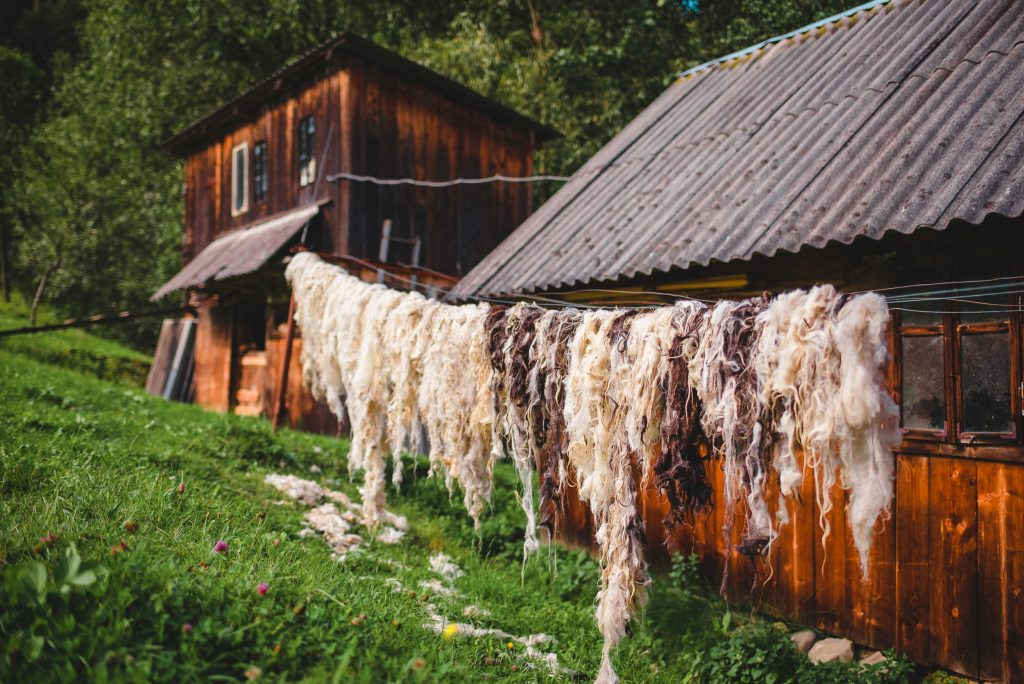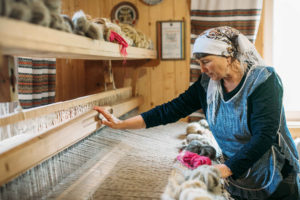Artisans of Ukraine: One Sheep = One Blanket
Cathy Koos

“To make a blanket, you must have a sheep.” Hanna Kopylchuk Ukrainer
From time immemorial, when war hits a country or population, many things are lost – obvious infrastructure like homes, stores, government buildings, churches, schools, and even the roads that connect these. Citizens flee the conflict and as refugees they may land far, far from their homes. More difficult to define is the intrinsic value of art and traditional crafts to a population’s culture.
When a people choose to emigrate from their homeland, they generally have time to gather the things that are important to them. When my great grandmother emigrated from Alsace Lorraine to America in 1880, she had two trunks that she filled with knitting needles, crochet hooks, and embroidery needles, in addition to linens and clothing. Many a craftswoman limited to a trunk for all her worldly possessions may have broken down her spinning wheel and only packed the flyer and drive wheel, confident that she could find a woodworker to build the rest. They would have likely not even considered bringing their loom, as those were easily constructed onsite.

Ukrainer, June 24, 2018
But when war erupts, a delay of a day or even a few hours can mean death, it becomes a grab-and-go situation. As we have watched evacuation in real time, we see people walking away from their homes pulling whatever is important to them in a single wheeled suitcase.
Ukraine is well-known for its pysanky Easter eggs and ruzhnyk, the traditional red embroidery on white linen. The designs are sacred, ancient symbols important for wedding and funeral rituals.
Lizhnyk, a type of woven woolen blanket, is another lesser-known textile created by the Hutsuls, an ethnic group in near Lviv in Yavoriv, Ukraine. As happens so often in central and eastern Europe, borders were quite fluid and for a fleeting period of time, the Hutsuls had their own republic nestled in the Carpathian Mountains.
“To make a blanket, you must have a sheep.” Hanna Kopylchuk Ukrainer
The Hutsulian blanket, or Lizhnyk (leesh – nik’) is a hearty, rustic blanket used primarily for bed coverings, vests and winter coats. It takes one sheep to make one blanket. This is a weft-faced blanket with the warp being spun much finer than the weft. The weft is about the size of pencil roving. Care must be taken when removing from the loom, and then the blanket is wet finished by tumbling in a stream and brushed on both sides, the weave structure is firmly set.
Early Lizhnyk blankets were natural colors of white, cream, gray and brown, and mainly striped in design. In the 1920s a local village girl and her new husband saw potential in the Lizhnyk and began to improve the looms and expand the technique to include contemporary designs and bright colors for a visual punch.
Ukrainer, June 24, 2018
By the 1930s, the blankets caught worldwide attention and were displayed at international expositions in Poland and the United States. From its mid-century peak, the number of Hutsul weavers has dwindled to about sixty in the village of Yavoriv. As of this writing in mid-April, the region around Yavoriv has been seeing heavy shelling from Russian troops, endangering both the future of the residents and the future of this traditional textile.
For weaving in action: https://youtu.be/CEnG4TkagBU